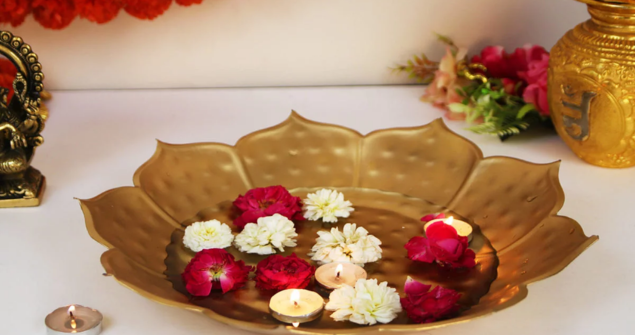A brass urli is a traditional decorative item commonly found in Indian households. It is a large, shallow bowl made of brass, typically adorned with intricate designs and patterns. The urli is often used as a centerpiece or a decorative element in homes, gardens, and temples. Traditionally, urli was used in Indian households for various purposes. One of its main functions was as a water vessel, where it was filled with water and flowers to create a visually pleasing arrangement. The water would also serve to cool the surrounding area, adding a touch of serenity to the environment.
Brass urli is also associated with religious and cultural significance. It is commonly used during religious ceremonies and festivals, where it is filled with water and adorned with flowers, candles, and other decorative items. The urli symbolizes abundance, prosperity, and auspiciousness. In recent times, brass urli has gained popularity as a decorative piece in contemporary interior design. Its elegant and timeless appeal makes it a sought-after item for adding a touch of traditional charm to modern spaces. Whether placed in the living room, patio, or garden, the brass urli adds a touch of warmth and cultural heritage. Overall, the brass urli is a beautiful and versatile decorative item that reflects the rich cultural traditions of India while adding an element of beauty and serenity to any space.
1. Historical Significance and Cultural Heritage

Brass urli has its roots deeply embedded in Indian history and culture. Urli is a traditional vessel originally used in South Indian households for various purposes, including cooking and decorative purposes during festivals. Made of brass, a metal that symbolises prosperity and abundance, the urli carries cultural significance and is believed to bring good fortune and positive energy into the home. Its presence is often associated with hospitality and welcoming guests.
2. Exquisite Designs and Versatile Shapes

Brass urli comes in a variety of shapes and sizes, allowing you to choose one that best suits your home’s style and decor. From small, intricately designed pieces to larger, more elaborate ones, there is a brass urli to fit every space. The designs range from traditional motifs and engravings to contemporary patterns, ensuring that you can find a urli that complements your personal taste and interior design theme.
3. Transforming Spaces with Brass Urli

A brass urli can instantly transform any space into a visual delight. Placing a urli in the entrance or foyer area creates a warm and inviting ambiance, setting the tone for the entire home. It can also be a stunning centerpiece for your living room, dining area, or garden, adding a touch of elegance and charm. One popular way to use a brass urli is by filling it with water and floating fresh flowers or scented candles. This creates a serene and soothing atmosphere, especially when the flickering candlelight reflects on the water. The urli can also be used as a decorative bowl to hold potpourri, decorative stones, or even as a unique planter for small indoor plants.
4. Maintenance and Care

To keep your brass urli looking beautiful, it is important to take proper care of it. Regular cleaning using a mixture of lemon juice and salt or a mild brass cleaner will help maintain its shine. Avoid using abrasive materials that could scratch the surface. Additionally, placing a protective layer, such as a clear lacquer, can prevent oxidation and tarnishing.
A brass urli is not just a decorative piece; it is a symbol of tradition, elegance, and cultural heritage. Its versatility and timeless appeal make it a stunning centerpiece for any home. Whether you choose a small urli for a subtle touch or a larger one to make a bold statement, incorporating a brass urli into your home decor will undoubtedly elevate its overall aesthetic. So, why not embrace the charm of a brass urli and let it bring warmth and beauty to your living space?

